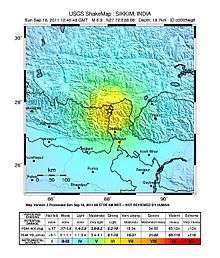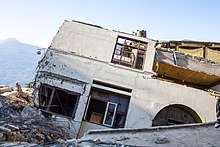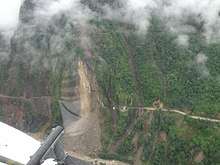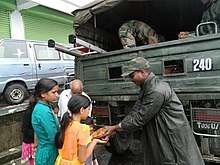2011 Sikkim earthquake
The 2011 Sikkim earthquake (also known as the 2011 Himalayan earthquake) occurred with a moment magnitude of 6.9 and was centered within the Kanchenjunga Conservation Area, near the border of Nepal and the Indian state of Sikkim, at 18:10 IST on Sunday, 18 September.[3] The earthquake was felt across northeastern India, Nepal, Bhutan, Bangladesh and southern Tibet.
 | |
| UTC time | 2011-09-18 12:40:51 |
|---|---|
| ISC event | 17238846 |
| USGS-ANSS | ComCat |
| Local date | 18 September 2011 |
| Local time | 18:10 IST 18:25 NPT 18:40 BTT 20:40 CST |
| Duration | 30–40 seconds |
| Magnitude | Mw 6.9 |
| Depth | 19.7 km (12.1 mi) |
| Epicenter | Taplejung, Nepal 27.723°N 88.064°E |
| Type | Intraplate[1] |
| Areas affected | India Bangladesh Nepal Bhutan China |
| Max. intensity | VII (Very strong)[2] |
| Landslides | Yes |
| Aftershocks | Yes |
| Casualties | At least 111 killed |
At least 111 people were killed in the earthquake.[4] Most of the deaths occurred in Sikkim, with reports of fatalities in and near Singtam in the East Sikkim district.[5] Several buildings collapsed in Gangtok.[6] Eleven are reported dead in Nepal, including three killed when a wall collapsed in the British Embassy in Kathmandu.[7] Elsewhere, structural damage occurred in Bangladesh, Bhutan, and across Tibet; another seven fatalities were confirmed in the latter region.
The quake came just a few days after an earthquake of 4.2 magnitude hit Haryana's Sonipat district, sending tremors in New Delhi.[8] The earthquake was the fourth significant earthquake in India of September 2011.[9]
Exactly a year after the original earthquake at 5:55 pm on 18 September 2012, another earthquake of magnitude 4.1 struck Sikkim, sparking panic among the people observing the anniversary of the original quake.[1][10][11][12]
Earthquake
The magnitude 6.9 (Mw) earthquake occurred inland at 18:10 IST on 18 September 2011, about 68 km (42 mi) northwest of Gangtok, Sikkim at a shallow depth of 19.7 km (12.2 mi).[3] At its location, the continental Indian and Eurasian Plates converge with one another along a tectonic boundary beneath the mountainous region of northeast India near the Nepalese border. Although earthquakes in this region are usually interplate in nature, preliminary data suggests the Sikkim earthquake was triggered by shallow strike-slip faulting from an intraplate source within the over-riding Eurasian Plate. Initial analyses also indicate a complex origin, with the perceived tremor likely being a result of two separate events occurring close together in time at similar focal depths.
Intensity

Located at a shallow depth beneath the surface, the earthquake caused strong shaking in many areas adjacent to its epicenter reportedly lasting 30 – 40 seconds.[13] The strongest shaking occurred to the west in Gangtok and further south in Siliguri, although similar ground motions registering at MMVI (strong) on the Mercalli scale were recorded in many smaller towns such as Mangan across elevated regions. Lighter tremors (MMIV – III) spread southward through populous regions, with these motions reported in the Patna capital of Bihar and as far southwest as Bihar Sharif.[2] In all, the earthquake was felt in Nepal, India, Bhutan, Bangladesh and China. Tremors were felt in Assam, Meghalaya, Tripura, parts of West Bengal, Bihar, Jharkhand, Uttar Pradesh, Rajasthan, Chandigarh and Delhi states of India.[14] In Tibet, the earthquake was felt in Shigatse and Lhasa.[15]
Aftershocks
Sikkim experienced three aftershocks since the earthquake, occurring at magnitudes of 5.7, 5.1, and 4.6 (Mw) within 30 minutes of the initial earthquake.[16] Kathmandu experienced two aftershocks that both had a magnitude of 4.8 Mw. The aftershocks had no serious impact in the region. At least 20 aftershocks back-to-back throughout the night created panic in the Gangtok.[17] On 19 September, tremors shook some parts of Maharashtra measuring 3.9 (Mw)[18] at around 06:30 IST including Latur, Osmanabad and Solapur districts, all of which had already suffered the 1993 earthquake.[19] However, no loss of life or property was reported.[20]
Impact
| Country | Deaths |
|---|---|
| 97 | |
| 7 | |
| 6 | |
| 1 | |
| 0 | |
| Total | 111 |

The earthquake struck near a mountainous, albeit very populous region near the Sikkim–Nepal border; most of the structures were reported to be highly vulnerable to earthquake shaking.[2] Upon impact, tens of thousands of residents evacuated their homes, and many areas suffered from communication and power outages. The strong shaking caused significant building collapse and mudslides;[13] at least 111 people were confirmed killed by the effects of the earthquake, and hundreds of others sustained injuries. As the earthquake occurred in the monsoon season, heavy rain and landslides rendered rescue work more difficult.[21]
India
Northern India suffered the most from the earthquake, with at least 75 people killed.[17] 60 people were reportedly killed in Sikkim alone.[22] At least 7 people have died in Bihar, while 6 deaths have been reported from West Bengal.[23] Power supply was disrupted in areas near Sikkim, including Kalimpong of Darjeeling district, and adjoining Jalpaiguri and Cooch Behar districts; the outages were in part blamed on an affected electric substation in Siliguri.[24] Water supply was interrupted in Sikkim. National Highway 31, the major highway linking Sikkim to the rest of India, was damaged.[21] Ten of the dead were workers at a hydroelectric project on the Teesta River.[25]
In India, property damage is estimated to be around ₹1,000 billion (US$14 billion) with the actual report yet to come.[26]
Sikkim

Two buildings of the Indo-Tibetan Border Police in the Pegong areas of North Sikkim collapsed.[27] In Gangtok, many government offices and hospitals were left unusable.[28] The heavy shaking destroyed the villages of Lingzya, Sakyong, Pentong, Bay and Tholong.[29]
Nepal
In the capital city of Nepal, Kathmandu, damage from the earthquake was comparatively limited. Three people were killed when a wall at the British Embassy collapsed, and many others suffered injuries. The shaking effects were more severe in eastern Nepal, which is closer to the epicenter. There, hundreds of homes sustained significant damage, and due to saturated soil from preceding heavy rains widespread mudslides impacted the region.[30] Sunsari experienced power and telephone communication outages. Two people were killed in the eastern city of Dharan.[31] Overall, in Nepal 6 people died due to the earthquake.
Bangladesh
The earthquake was felt most strongly in northern Bangladesh. The quake was also felt in Dhaka, Rajshahi, Sylhet, Mymensingh, Barisal, Faridpur, Jessore, Khulna, Pabna, Bogra, Comilla, Noakhali, Chittagong and as far as Cox's Bazar.[32] Panicked people rushed out of their homes and offices,[32][33] but the only damage seems to be tilted and cracked buildings;[34] no casualties were reported.[33] Cell phone lines were also down for a few minutes during the quake.[33]
China
In Tibet, building collapse was reported in Yadong,[35] Dinggyê and Gamba.[15] At least seven people were reported dead in Yadong.[36] Telephone service was interrupted in the seat of Yadong County.[37]
Bhutan
There were no reports of casualties in Bhutan, although cracks on walls and ceilings of houses were reported in Wangthangkha village, Lango and the town area in Paro. There were also reports of a landslide right after crossing the Isuna Bridge from Paro towards Thimphu, and falling boulders after crossing Chundzom Bridge. Citizens were asked to avoid traveling on the Paro-Thimphu highway. Telecommunications networks were disrupted, with cellular networks unavailable after the quake.[38]
Prime Minister of Bhutan Jigmi Thinley updated in his status[39] as "Phone lines remains clogged reflecting our caring and close knit society. No damage reported from East Bhutan. Four road blocks caused by falling debris are reported on the Chukha – Phuntsholing road. Two homes in Haa report damage with 3–4 people having suffered minor injury. Thimphu Dzong has sustained some cracks in the Utse and one of the four corner towers. Occupants have been moved out to safer parts. Please remain calm and alert."
Rescue operations and compensation
.jpg)

Early rescue operations included four teams of National Disaster Response Force been rushed to Sikkim and five more teams were being sent from Kolkata.[16] However, South and West Sikkim remained inaccessible delaying rescue operations owing to landslides caused by rainfall. A group of 14 tourists were rescued by the army from north Sikkim. The army had deployed 72 columns including infantry troops, combat engineers, four Dhruv and five Cheetah helicopters. Rain and landslides had hampered the rescue efforts of workers searching for survivors.[17][40]
Indian former Prime Minister Dr. Manmohan Singh, on 19 September, announced ₹200,000 (US$2,800) as ex-gratia to a family member of those killed in the earthquake and ₹100,000 (US$1,400) for seriously injured. ₹50,000 (US$700) for those grievously injured and ₹25,000 (US$350) for those with minor injuries was announced by Sikkim former chief minister Pawan Chamling.[17] Rescue and relief operations resumed in Sikkim since early in the morning on Tuesday with the weather showing signs of improvement. Road opening parties succeeded in restoring communication along NH31A and work was continuing to repair the North Sikkim Highway to Mangan and Chungthang. Fifteen helicopters have been pressed into service to evacuate casualties and deploy rescue and relief columns in the affected areas of north and west Sikkim.
Lt Gen Bikram Singh, GOC-in-C, Eastern Command, also visited the earthquake-affected areas and met his senior staff officers to discuss the progress of Operation Trishakti Madad, the massive operation launched by the Army's 33 Corps to provide relief to those affected by Sunday's earthquake.
According to the Army, nearly 2,000 civilians are being provided shelter at eight Army relief camps at Gangtok, Chungthang, Pegong and Darjeeling. There are 400 others who have sought shelter at relief camps set up by the Indo-Tibetan Border Police. Several children from these camps even returned home on Tuesday and attended school
On Monday, when weather improved, Special Forces personnel slithered from helicopters into affected villages. Medical camps were set up and arrangements were made for casualty evacuation
21 engineering columns of the Army succeeded in restoring partial road connectivity to parts of north Sikkim on Tuesday. Telecommunications and power lines, that snapped due to the earthquake, were also restored.
In spite off all efforts, the highway to Gangtok remained badly affected due to landslides
References
- "Magnitude 6.9 – Sikkim, India: Tectonic Summary". United States Geological Survey. 18 September 2011. Archived from the original on 21 September 2011. Retrieved 18 September 2011.
- "Pager – M 6.9 – Sikkim, India". United States Geological Survey. 18 September 2011. Archived from the original on 23 September 2011. Retrieved 18 September 2011.
- "Magnitude 6.9 – SIKKIM, INDIA". United States Geological Survey. 18 September 2011. Archived from the original on 21 September 2011. Retrieved 18 September 2011.
- Himalayan quake toll climbs to 116, 40 stranded foreign tourists rescued, DNA, 21 September 2011
- Earthquake claims two lives in Sikkim, The Hindu, 18 September 2011
- Bhardwaj, Mayank (18 September 2011). "Magnitude 6.8 quake in India, several dead". Reuters. Retrieved 18 September 2011.
- Earthquake kills 5 in Nepal, DNA, 18 September 2011
- "Very strong earthquake in SIKKIM, India". 18 September 2011. Earthquake-report.com. 18 September 2011.
- "Sikkim quake is India's fourth this september". NDTV. 18 September 2011. Retrieved 18 September 2011.
- Press Trust of India (18 September 2012). "Moderate quake jolts Sikkim, no report of casualty, damage". business-standard.com.
- Abhinav Bhatt (18 September 2012). "Tremor felt in Sikkim, exactly a year after devastating quake". NDTV.com.
- "Geological Survey of India" (PDF). 18 September 2012. Archived from the original (PDF) on 3 March 2016. Retrieved 12 November 2012.
- "Eight killed, 100 injured as strong quake jolts Sikkim-Nepal border region". The Economic Times. 18 September 2011. Retrieved 18 September 2011.
- "Quake toll mounts to 6 as quake jolts east, north India". The Times of India. 18 September 2011. Retrieved 18 September 2011.
- "受印度地震影响西藏边境地区部分房屋倒塌 一人受伤_资讯频道_凤凰网". News.ifeng.com. Retrieved 18 September 2011.
- "2 killed in Sikkim, buildings hit as quake jolts Northeast". DNA India. 18 September 2011. Retrieved 18 September 2011.
- "Sikkim earthquake toll rises to 50". The Times of India. 19 September 2011. Retrieved 19 September 2011.
- "Quake rattles Maharashtra". The Deccan Chronicle. 19 September 2011. Archived from the original on 19 September 2011. Retrieved 19 September 2011.
- "Earthquake jolts several parts of Maharashtra today". The Times of India. 19 September 2011. Retrieved 19 September 2011.
- "Quake jolts several parts of Maharashtra". CNN-IBN. Retrieved 19 September 2011.
- "Sikkim the morning after offers a grim picture". Ndtv.com. Retrieved 19 September 2011.
- "35 tourists airlifted, toll crosses 90". The Times of India. 21 September 2011. Retrieved 21 September 2011.
- "Sikkim earthquake toll climbs to 66, rescue work hampered by landslides". The Times of India. 19 September 2011. Retrieved 19 September 2011.
- "Many injured in northbengal, power supply disrupted". NDTV. 18 September 2011. Retrieved 18 September 2011.
- 10 bodies recovered from Teesta project: ITBP Archived 6 February 2012 at the Wayback Machine, News One / IANS, 19 September 2011
- "Nine villages still inaccessible, damage estimated at Rs 1 lakh crore". The Times of India. 21 September 2011. Retrieved 21 September 2011.
- Sikkim quake: ITBP buildings collapse, Pegong area badly hit, The Economic Times, 18 September 2011
- "Earthquake toll over 80; India 68; as rescue teams reach quake epicentre". Ndtv.com. Retrieved 22 September 2011.
- "The Times of India on Mobile". Sp.m.timesofindia.com. Retrieved 22 September 2011.
- Adhikari, Prakash (19 September 2011). "Quake hits vast Himalayan region killing 63". Agence France-Presse. Retrieved 19 September 2011.
- "Powerful quake rocks Nepal, at least five killed". 18 September 2011. Nepalmountainnews.com. Archived from the original on 4 January 2013. Retrieved 18 September 2011.
- "6.8 tremor jolts Dhaka, Ctg, Sylhet". bdnews24.com. 18 September 2011. Archived from the original on 25 September 2011. Retrieved 18 September 2011.
- "Powerful quake jolts Bangladesh, sparks panic". Times of India. 18 September 2011. Retrieved 18 September 2011.
- "Two Dhaka buildings damaged in quake". bdnews24.com. 18 September 2011. Archived from the original on 2 April 2012. Retrieved 18 September 2011.
- "印度锡金邦地震造成西藏7人死亡 亚东县受灾严重_资讯频道_凤凰网". News.ifeng.com. Retrieved 19 September 2011.
- 3088. "西藏亚东县7人因地震死亡 消防救援-社会-人民网". 119.people.com.cn. Retrieved 19 September 2011.CS1 maint: numeric names: authors list (link)
- "印度锡金邦地震波及中国西藏边境地区_社会频道_新华网". News.xinhuanet.com. Retrieved 19 September 2011.
- Powerful tremor rock western Bhutan, Kuensel online, 19 September 2011
- "Aanmelden". Facebook. Retrieved 22 September 2011.
- "Sikkim earthquake: Landslides hamper rescue efforts, toll 40". The Times of India. 19 September 2011. Retrieved 19 September 2011.
External links
- Rediff.com: 40 killed in Sikkim quake; relief ops hit by landslides (slideshow)
- The Mw 6.9 Sikkim-Nepal Border Earthquake of September 18, 2011 – Earthquake Engineering Research Institute
- The International Seismological Centre has a bibliography and/or authoritative data for this event.
- ReliefWeb's main page for this event.